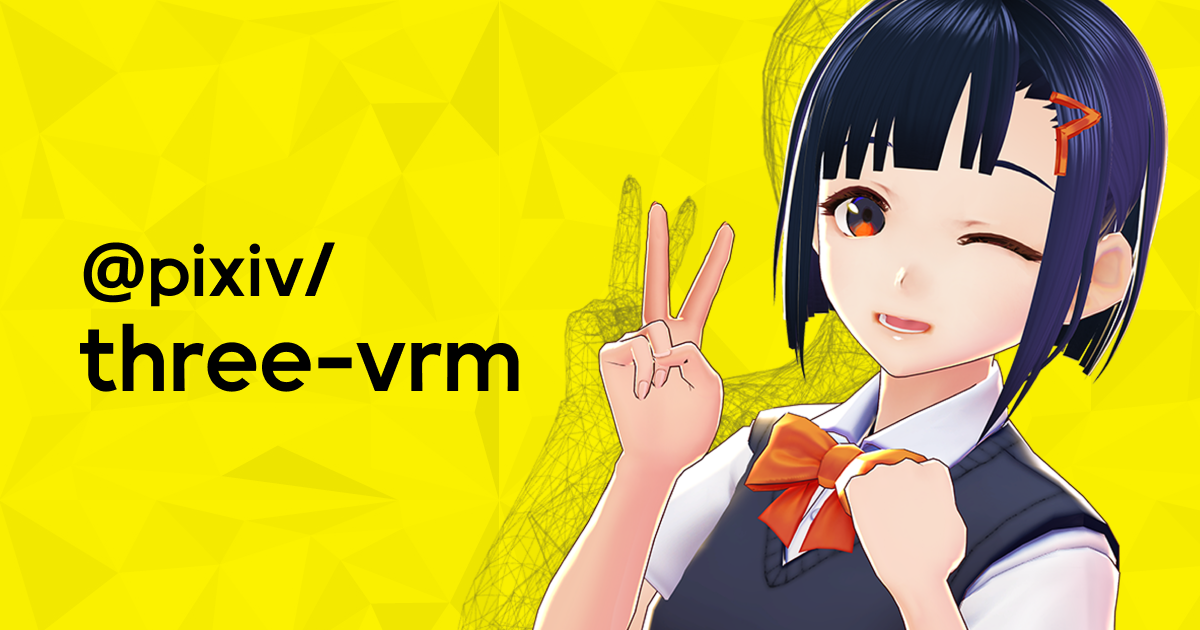@pixiv/three-vrmUse VRM em três.js

Repositório do GitHub
Exemplos
Documentações
Referência da API
Você precisará:
.module Ones são ESM, caso contrário, é umd e injeta seus módulos em THREE globais.min , são minificados (para produção), caso contrário, não é minificado e vem com mapas de origemVocê pode importar todas as dependências via CDN como o JSDelivr.
< script type =" importmap " >
{
"imports" : {
"three" : "https://cdn.jsdelivr.net/npm/[email protected]/build/three.module.js" ,
"three/addons/" : "https://cdn.jsdelivr.net/npm/[email protected]/examples/jsm/" ,
"@pixiv/three-vrm" : "https://cdn.jsdelivr.net/npm/@pixiv/three-vrm@3/lib/three-vrm.module.min.js"
}
}
</ script >
< script type =" module " >
import * as THREE from 'three' ;
import { GLTFLoader } from 'three/addons/loaders/GLTFLoader.js' ;
import { VRMLoaderPlugin } from '@pixiv/three-vrm' ;
// ... Setup renderer, camera, scene ...
// Create a GLTFLoader - The loader for loading VRM models
const loader = new GLTFLoader ( ) ;
// Install a GLTFLoader plugin that enables VRM support
loader . register ( ( parser ) => {
return new VRMLoaderPlugin ( parser ) ;
} ) ;
loader . load (
// URL of the VRM you want to load
'/models/VRM1_Constraint_Twist_Sample.vrm' ,
// called when the resource is loaded
( gltf ) => {
// retrieve a VRM instance from gltf
const vrm = gltf . userData . vrm ;
// add the loaded vrm to the scene
scene . add ( vrm . scene ) ;
// deal with vrm features
console . log ( vrm ) ;
} ,
// called while loading is progressing
( progress ) => console . log ( 'Loading model...' , 100.0 * ( progress . loaded / progress . total ) , '%' ) ,
// called when loading has errors
( error ) => console . error ( error ) ,
) ;
// ... Perform the render loop ...
</ script >Veja o documento três.js se você ainda não conhece o Three.js: https://threejs.org/docs/#manual/en/introduction/creating-a-scene
Veja o exemplo para o código completo: https://github.com/pixiv/three-vrm/blob/release/packages/three-vrm/examples/basic.html
Instale three e @pixiv/three-vrm :
npm install three @pixiv/three-vrm A partir da V3, fornecemos compatibilidade com o WebGPureRender. Para usar o Three-VRM com o WebGPureRender, especifique o MToonNodeMaterial COMPATÍVEL DE WEBGPU para a opção materialType do MToonMaterialLoaderPlugin .
MToonNodeMaterial suporta apenas três.js R167 ou posterior. O sistema nodematerial de três.js ainda está em desenvolvimento; portanto, podemos quebrar a compatibilidade com versões mais antigas de três.js com mais frequência do que outras partes de três-VRM.
import { GLTFLoader } from 'three/addons/loaders/GLTFLoader.js' ;
import { MToonMaterialLoaderPlugin , VRMLoaderPlugin } from '@pixiv/three-vrm' ;
import { MToonNodeMaterial } from '@pixiv/three-vrm/nodes' ;
// ... Setup renderer, camera, scene ...
// Create a GLTFLoader
const loader = new GLTFLoader ( ) ;
// Register a VRMLoaderPlugin
loader . register ( ( parser ) => {
// create a WebGPU compatible MToonMaterialLoaderPlugin
const mtoonMaterialPlugin = new MToonMaterialLoaderPlugin ( parser , {
// set the material type to MToonNodeMaterial
materialType : MToonNodeMaterial ,
} ) ;
return new VRMLoaderPlugin ( parser , {
// Specify the MToonMaterialLoaderPlugin to use in the VRMLoaderPlugin instance
mtoonMaterialPlugin ,
} ) ;
} ) ;
// ... Load the VRM and perform the render loop ...Veja o exemplo do código completo: https://github.com/pixiv/three-vrm/blob/release/packages/three-vrm/examples/webgpu-dnd.html
Veja: Contribuindo.md
Mit